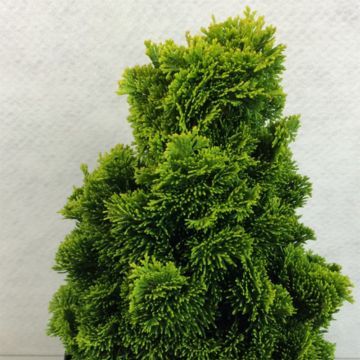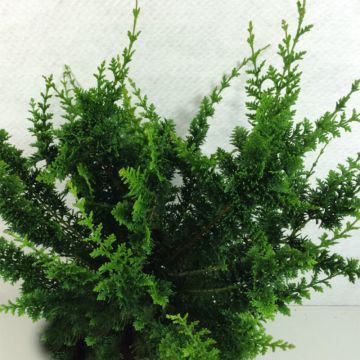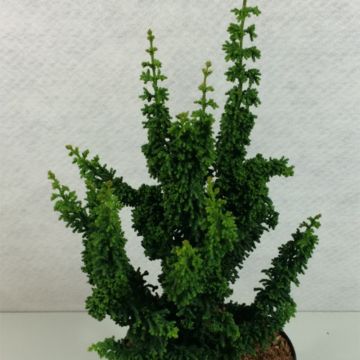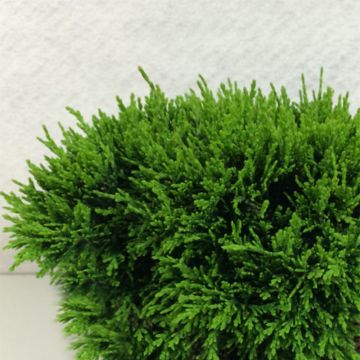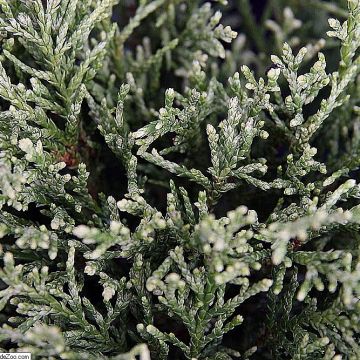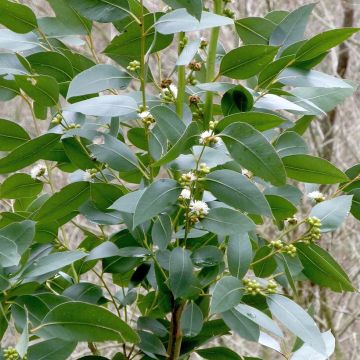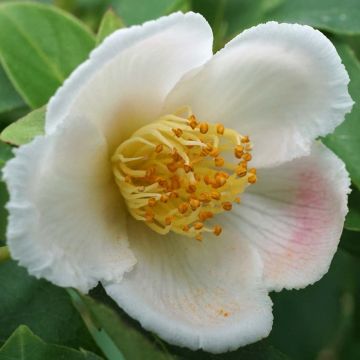

Chamaecyparis lawsoniana Yellow Spire - Cyprès de Lawson nain
Chamaecyparis lawsoniana Yellow Spire - Lawson Cypress
Chamaecyparis lawsoniana Yellow Spire
Lawson's Cypress, False Cypress, Port Orford-cedar, Oregon cedar, White cedar
Arrived at its peak form. Despite my careful care (in a pot), the centre of the young plant has become bare during the summer. It has therefore lost some of its splendour! But the rest is very green. I am waiting to see in the spring. Very original and elegant shape. It is better to showcase it on its own.
Catherine S., 28/11/2018
Why not try an alternative variety in stock?
View all →This plant carries a 24 months recovery warranty
More information
We guarantee the quality of our plants for a full growing cycle, and will replace at our expense any plant that fails to recover under normal climatic and planting conditions.
From €5.90 for pickup delivery and €6.90 for home delivery
Express home delivery from €8.90.
Does this plant fit my garden?
Set up your Plantfit profile →
Description
Chamaecyparis lawsonia Yellow Spire is a small conifer with a slightly gangly appearance and a conical and very narrow habit, which gives it a very unique silhouette. Its curiously twisted feathery branches are covered in spring with red pollen sacs contrasting with its bright green-yellow young foliage which becomes bluish-green with age. Not exceeding 1.50m (4ft 11in) in height at maturity, it grows slowly and is particularly suitable for permanent decoration in small spaces, rockeries and containers. It thrives in sunny locations and cool, fertile, slightly limestone, neutral or slightly acidic soils.
The Lawson Cypress, sometimes called false-cypress, is a majestic conifer of the Cupressaceae family native to the moist coastal forests of the northwest United States. In its natural environment, it often reaches heights of over 30m (98ft 5in), with a trunk approaching 1.20m (3ft 11in) in diameter. Its habit is straight and conical, and its trailing branches form soft curtains adorned with fairly dark, bluish-green foliage. It has given rise to numerous cultivars, including a wide range of small-sized plants.
The Yellow Spire variety is a dwarf form of this species, but also a mutation of the Chamaecyparis lawsonia Little Spire. This conifer has a very narrow arrow-like habit, not exceeding 1.20m (3ft 11in) in height and 40cm (15.7in) in width after 10 years of cultivation. At maturity, it will form a very slender small bush, on average 2.75m (9ft) tall by 1.05m (3ft 5in) wide, with tousled growth. It produces numerous slender and irregular flattened branches, covered with two types of scale-like leaves, of a lovely acidic green colour when they emerge at the tips of the branches in spring, turning bluish-green in winter. In May, the tree offers a stunning spectacle, when its acidic green foliage is covered for a few days with numerous bright red male cones followed by the appearance of a cloud of red pollen.
The Chamaecyparis lawsonia Yellow Spire, with its unusual silhouette and small size, is ideal for decorating a rockery or flowerbed, or planted in groups of 3 in a container. It does not require pruning. The architectural qualities of dwarf conifers naturally impose themselves in the design of a contemporary garden, which prefers the aesthetics of shapes, silhouettes, and textures to flowers. These plants durably structure a flowerbed, mark pathways and border terraces, easily substituting the strong presence of trimmed boxwood. They serve as a backdrop for small roses, peonies, or tousled grasses with a very complementary form. They can also be associated with shrubs or ground cover plants such as aubrietas and ceraistes, as well as flowering shrubs. The key is to play with volumes and colours.
Report an error about the product description
Chamaecyparis lawsoniana Yellow Spire - Lawson Cypress in pictures




Plant habit
Flowering
Foliage
Botanical data
Chamaecyparis
lawsoniana
Yellow Spire
Cupressaceae
Lawson's Cypress, False Cypress, Port Orford-cedar, Oregon cedar, White cedar
North America
Other Chamaecyparis
Planting and care
The Yellow Spire Chamaecyparis lawsonia should be planted in spring or autumn, in a light soil that retains moisture, rich in humus or sandy, and slightly acidic or neutral as it does not tolerate excessive limestone. This conifer thrives in sunlight (in a fairly humid climate) or in partial shade. Regularly water the young plants during the months following planting. This conifer is not too demanding in terms of soil quality, but it suffers in excessively dry soils. It is a species that prefers a cool, oceanic or mountain climate. This bush does not require pruning, but any unsightly or obstructive branches can be removed to enhance its unique habit.
Planting period
Intended location
Care
-
, onOrder confirmed
Reply from on Promesse de fleurs
Evergreen shrubs
Haven't found what you were looking for?
Hardiness is the lowest winter temperature a plant can endure without suffering serious damage or even dying. However, hardiness is affected by location (a sheltered area, such as a patio), protection (winter cover) and soil type (hardiness is improved by well-drained soil).

Photo Sharing Terms & Conditions
In order to encourage gardeners to interact and share their experiences, Promesse de fleurs offers various media enabling content to be uploaded onto its Site - in particular via the ‘Photo sharing’ module.
The User agrees to refrain from:
- Posting any content that is illegal, prejudicial, insulting, racist, inciteful to hatred, revisionist, contrary to public decency, that infringes on privacy or on the privacy rights of third parties, in particular the publicity rights of persons and goods, intellectual property rights, or the right to privacy.
- Submitting content on behalf of a third party;
- Impersonate the identity of a third party and/or publish any personal information about a third party;
In general, the User undertakes to refrain from any unethical behaviour.
All Content (in particular text, comments, files, images, photos, videos, creative works, etc.), which may be subject to property or intellectual property rights, image or other private rights, shall remain the property of the User, subject to the limited rights granted by the terms of the licence granted by Promesse de fleurs as stated below. Users are at liberty to publish or not to publish such Content on the Site, notably via the ‘Photo Sharing’ facility, and accept that this Content shall be made public and freely accessible, notably on the Internet.
Users further acknowledge, undertake to have ,and guarantee that they hold all necessary rights and permissions to publish such material on the Site, in particular with regard to the legislation in force pertaining to any privacy, property, intellectual property, image, or contractual rights, or rights of any other nature. By publishing such Content on the Site, Users acknowledge accepting full liability as publishers of the Content within the meaning of the law, and grant Promesse de fleurs, free of charge, an inclusive, worldwide licence for the said Content for the entire duration of its publication, including all reproduction, representation, up/downloading, displaying, performing, transmission, and storage rights.
Users also grant permission for their name to be linked to the Content and accept that this link may not always be made available.
By engaging in posting material, Users consent to their Content becoming automatically accessible on the Internet, in particular on other sites and/or blogs and/or web pages of the Promesse de fleurs site, including in particular social pages and the Promesse de fleurs catalogue.
Users may secure the removal of entrusted content free of charge by issuing a simple request via our contact form.
The flowering period indicated on our website applies to countries and regions located in USDA zone 8 (France, the United Kingdom, Ireland, the Netherlands, etc.)
It will vary according to where you live:
- In zones 9 to 10 (Italy, Spain, Greece, etc.), flowering will occur about 2 to 4 weeks earlier.
- In zones 6 to 7 (Germany, Poland, Slovenia, and lower mountainous regions), flowering will be delayed by 2 to 3 weeks.
- In zone 5 (Central Europe, Scandinavia), blooming will be delayed by 3 to 5 weeks.
In temperate climates, pruning of spring-flowering shrubs (forsythia, spireas, etc.) should be done just after flowering.
Pruning of summer-flowering shrubs (Indian Lilac, Perovskia, etc.) can be done in winter or spring.
In cold regions as well as with frost-sensitive plants, avoid pruning too early when severe frosts may still occur.
The planting period indicated on our website applies to countries and regions located in USDA zone 8 (France, United Kingdom, Ireland, Netherlands).
It will vary according to where you live:
- In Mediterranean zones (Marseille, Madrid, Milan, etc.), autumn and winter are the best planting periods.
- In continental zones (Strasbourg, Munich, Vienna, etc.), delay planting by 2 to 3 weeks in spring and bring it forward by 2 to 4 weeks in autumn.
- In mountainous regions (the Alps, Pyrenees, Carpathians, etc.), it is best to plant in late spring (May-June) or late summer (August-September).
The harvesting period indicated on our website applies to countries and regions in USDA zone 8 (France, England, Ireland, the Netherlands).
In colder areas (Scandinavia, Poland, Austria...) fruit and vegetable harvests are likely to be delayed by 3-4 weeks.
In warmer areas (Italy, Spain, Greece, etc.), harvesting will probably take place earlier, depending on weather conditions.
The sowing periods indicated on our website apply to countries and regions within USDA Zone 8 (France, UK, Ireland, Netherlands).
In colder areas (Scandinavia, Poland, Austria...), delay any outdoor sowing by 3-4 weeks, or sow under glass.
In warmer climes (Italy, Spain, Greece, etc.), bring outdoor sowing forward by a few weeks.






































